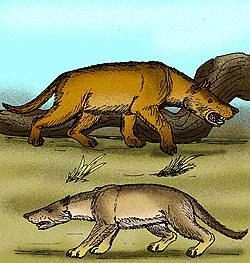Phanerozoic/Paleogene period
 |
|
Cenozoic |
|---|
|
Mesozoic |
|
Paleozoic |
|
|
|
|
The Paleogene Period is the first of two periods which make up the Cenozoic Era. Beginning 65.6 million years ago and lasting until 23.05 million years ago, the Paleogene was a time of great change. Many new flora and fauna began to appear which looked much like our current life. The global climate went through a series of changes which encouraged the changing life.
The Paleogene period, its epochs, the the two Neogene epochs Miocene and Pliocene, were formerly known as the Tertiary Period, however that term is no longer in use yet may still be seen in publications. The Paleogene is divided into three different epochs which then are separated into several stages:
| Period | Epoch | Stage |
|---|---|---|
| Paleogene (65.5-23.03 MYA) |
Oligocene (33.9-23.03 MYA) |
Chattian (28.45-23.03 MYA) |
| Rupelian (33.90-28.45 MYA) | ||
| Eocene (55.8-33.9 MYA) |
Priabonian (37.2-33.9 MYA) | |
| Bartonian (40.4-37.2 MYA) | ||
| Lutetian (48.6-40.4 MYA) | ||
| Ypresian (55.8-48.6 MYA) | ||
| Paleocene (65.5-55.8 MYA) |
Thanetian (58.7-55.8 MYA) | |
| Selandian (61.7 - 58.7 MYA) | ||
| Danian (65.5-61.7 MYA) |
Paleocene Epoch: 65 - 55 MYA
[edit | edit source]
The beginning of the Paleocen epoch, meaning "ancient recent life", is marked by the Late Cretaceous extinction event. Many flora and fauna from the Cretaceous were devastated. Almost all reptiles, most famously the dinosaurs, were all made extinct. The most accepted theory for this extinction is that of a 10 kilometer or larger asteroid collision. Much of the seafloor of today formed during the Paleocene. The plate movement of the period had the continents moving toward our modern continental configuration, with Antarctica and Australia ready to separate and India on a collision course toward Asia.
Fauna and Flora
[edit | edit source]A great rise in the variety and number animal species, especially mammals, was occurring during the Paleocene. While remaining relatively small in size and shorter in stature, the mammals of the Paleocene resembled much of what we have today. Along with the rise of mammals, there were various marine life that was thriving as the oceans so a proliferation of sharks and the appearance of squids. Among some of the more interesting animals to appear were large flightless birds. These large creatures, sometimes referred to as "terrorbirds" began appearing near the end of the Paleocene. With the advent of angiosperms, many types on insects began to appear to assist with the process of pollination.
The Paleocene brought a few familiar plants into life. Plants such as the cactus and palm trees first came into being. Angiosperms continued to diversify and cover the Earth. As the Earth began warming up near the end of the Paleocene, there was a shift in flora to more tropical plants.
Climate
[edit | edit source]The absence of many Cretaceous species was only part of the changes the Paleocene brought. Near the end of the Paleocene, the Earth began to undergo a period of global warming. The warming of the Earth, referred to as the Paleocene-Eocene Thermal Maximum, is thought to be caused by the massive release of methane from the ocean. With an abundance of methane, it acted as a greenhouse effect, warming the Earth.
Eocene Epoch: 55 - 34MYA
[edit | edit source]The Eocene, meaning "Dawn of Recent Life", continued with the warming that began during the late Paleocene. The continents continued to push India further toward Asia. With Australia, South America, and Antarctica separating and other land masses beginning to connect, the animal life is given the opportunity to evolve independently from each other.
Climate
[edit | edit source]The Eocene greenhouse effect that began Late-Paleocene continued the warming trend, lending it self to a tropic climate. The end of the Eocene brought a change to the climate as the Earth began to experience a period of cooling.
Oligocene Epoch: 34 - 23 MYA
[edit | edit source]Meaning "slightly recent life", the Oligocene began with a drop in temperature. India, which had been traveling toward Asia, finally collides, eventually creating the Himalayas.
Fauna and Flora
[edit | edit source]As the Earth began to cool, the tropical plants that had previously been found relatively widespread began to recede towards the equator where it was still warm. The general tropical plants began a transition to more forest like areas. The first grasses also appeared in the late Oligocene. The appearance of these grasses led to to evolution of various herbivore animals. With bodies low to the ground, animals would take advantage of the new grasses that appeared.
Climate
[edit | edit source]The Oligocene marks the end of the warming that the Paleogene brought. An extensive period of cooling began to take hold as the Oligocene progressed. With Australia completely free from Antarctica, the cool waters are able to move further north. This cooling environment ended many species that were only able to survive in the warm regions and were unable to smoothly make the transition.
References
[edit | edit source]Gradstein, Felix, James Ogg, Alan Smith, ed. A Geologic Time Scale 2004. Cambridge: Cambridge University Press, 2004.
Levin, Harold L. The Earth Through Time. 8th ed. Hoboken: John Wiley & Sons Inc., 2006.
"When Giant Birds Reigned Supreme." Science Illustrated Jan./Feb. 2010: 34-39
Stephens, Tim. "Global Warming Episode Between Paleocene And Eocene" www.unisci.com. UniSci, Mar. 2003. Web. 11 April 2010.
"PALAEOS: The history of life on Earth" www.palaeos.com. n.d. 11 Apr 2010.
"Paleocene" http://www.paleocene.com/paleocene.html. n.d. 19 May 2010.
